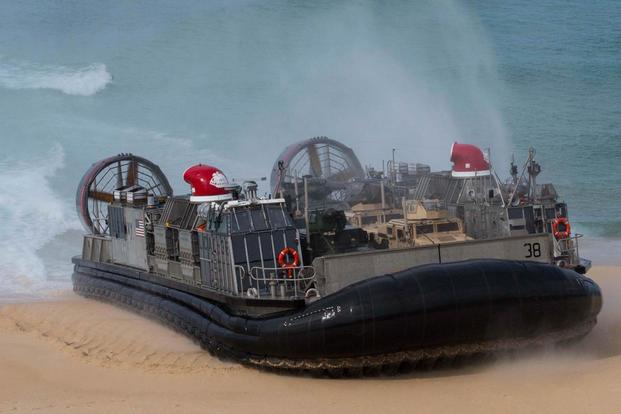The conventional Marine Corps ship-to-shore landing craft of past decades may not be rugged or versatile enough to support the service's invasion force in a future fight, the general nominated to be the next commandant said this week.
Lt. Gen. David Berger told members of the Senate Armed Services Committee's subcommittee on seapower Wednesday that the days of building combat power in secure areas of a theater are over.
"The past 18 years of operating out of forward operating bases where you could pile as much sustainment as you want, protect and operate from there -- that fit the operating environment of the Middle East," Berger said. "It does not fit the operating environment that's our primary theater now."
Berger's comments came after Sen. Angus King, I-Maine, asked Berger for a status update on the Marine Corps ship-to-shore connector capabilities during a hearing to discuss ground modernization programs in the proposed fiscal 2020 budget and the Future Years Defense Program.
Current ship-to-shore connectors in use by the Marine Corps include the landing craft-air cushion hovercraft, or LCAC, and the landing craft utility vessel, or LCU. Neither are designed to provide protection in contested environments.
"We are going to need more connectors -- a family of connectors going forward," Berger said. "Connectors to us, before today, was a way to move from ship to shore. But connectors now are ship-to-shore, shore-to-ship, shore-to-shore. We need the vertical. We need the surface ... we need it all."
The Marine Corps, like the rest of the U.S. military, is preparing to fight against a near-peer competitor such as Russia or China in a contested, operational environment that will likely force units to operate on their own for longer periods of time without traditional lines of support, military officials said.
"If we are going disperse and be able to operate in a distributed manner and sustain that force, our view of what connectors are is going to have to broaden," Berger said.
King asked if the Corps is designing these new connectors to be able to cope with the challenges of this new, battlefield environment.
"It seems to me that we are also going to have to think of a contested environment -- GPS disruption, communications disruptions. Is that part of your thinking in terms of designing these systems?" King asked.
Berger said that command-and-control in a contested environment is the Marine Corps' top priority.
"We have to write it into our requirements for all of our systems," Berger said. "If there is a system that we have that can't function under ... an adversary's pressure, then it's not going to last very long. It's going to go quiet."
Such an environment will require Marine units to fight their way into a fight, said Sen. David Perdue, R-Georgia, who asked Berger to describe how the Corps would protect its sealift capabilities as they move into a contested environment.
Traditional maritime prepositioned stocks of equipment and supplies are not suited to support the future battlefield, Berger said.
"We are going to have to re-look that going forward, because that was built on a premise that you would have secure, benign ports that you could drive up next to in your 38-foot draft vessel and unload as we did in Desert Shield/Desert Storm, and just keep cycling them in," Berger said.
"We need to be able to do those kinds of things at sea to a connector and then maybe onto another connector. Some will be prepositioned forward, either afloat or ashore, and then the rest that is brought in -- the distribution of that sustainment is varsity-level stuff."
-- Matthew Cox can be reached at matthew.cox@military.com.













